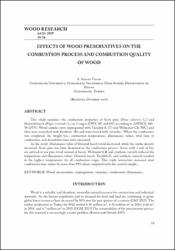EFFECTS OF WOOD PRESERVATIVES ON THE COMBUSTION PROCESS AND COMBUSTION QUALITY OF WOOD
Access
Attribution 3.0 United Statesinfo:eu-repo/semantics/closedAccesshttp://creativecommons.org/licenses/by/3.0/us/Date
2019Access
Attribution 3.0 United Statesinfo:eu-repo/semantics/closedAccesshttp://creativecommons.org/licenses/by/3.0/us/Metadata
Show full item recordAbstract
This study examines the combustion properties of Scots pine (Pinus sylvestris L.) and Oriental beech (Fagus orientalis L.) in 3 stages (CWF, SC and EC) according to ASTM E 160-50 (1975). Wood samples were impregnated with Tanalith-E (T) and Wolmanit-CB (WC) and then were varnished with Synthetic (St) and water based (wb) varnishes. When the combustion was completed, the weight loss, combustion temperatures, illuminance values, total time of combustion, and demolition time were measured. As the result, illuminance value of Oriental beech wood decreased, while the smoke density increased. Scots pine was later destroyed in the combustion process. Areas with a risk of fire are advised to use pine wood instead of beech. Wolmanit-CB and synthetic varnish reduced the temperature and illuminance values. Oriental beech, Tanalith-E, and synthetic varnish resulted in the highest temperatures for all combustion stages. This triple interaction increased total combustion time values by more than 90% when compared with the control samples.
Volume
64Issue
1Collections
The following license files are associated with this item:



















